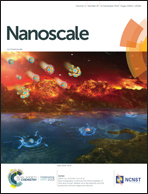Characterization and manipulation of single nanoparticles using a nanopore-based electrokinetic tweezer†
Abstract
Manipulation and characterization of nanoscale objects through electrokinetic techniques offer numerous advantages compared to the existing optical methods and hold great potential for both fundamental research and practical applications. Here we present a novel electrokinetic tweezer for single nanoparticle manipulation and characterization based on electrokinetic trapping near a low-aspect-ratio nanopore. We find that this nanopore-based electrokinetic tweezer share lots of similarity with optical tweezers and can be modeled as an overdamped harmonic oscillator, with the spring constant of the system being the trap stiffness. We show that different values of ionic currents through the nanopore and trap stiffnesses are achieved when trapping nanoparticles with different sizes (down to 100 nm) and/or zeta potentials. We also demonstrate that the trap stiffness and nanoparticle position can be easily tuned by changing the applied voltage and buffer concentration. We envision that further development of this electrokinetic tweezer will enable various advanced tools for nanophotonics, drug delivery, and biosensing.



 Please wait while we load your content...
Please wait while we load your content...